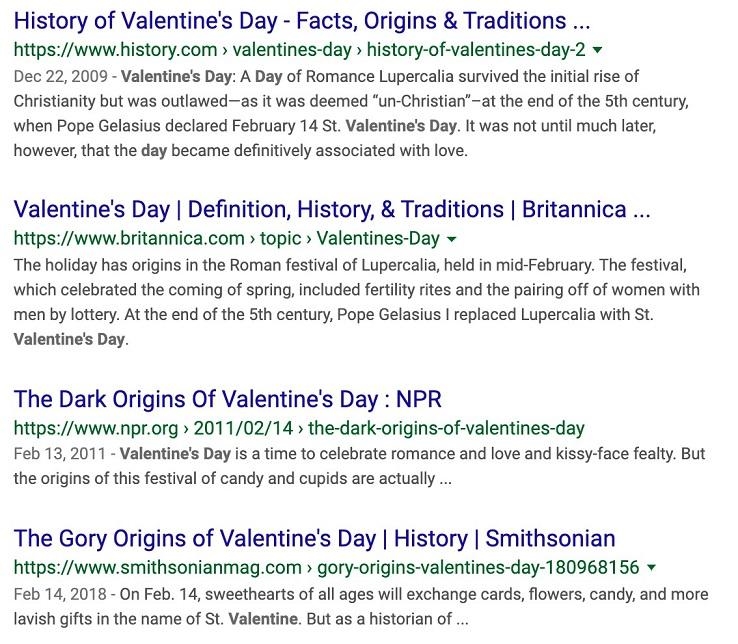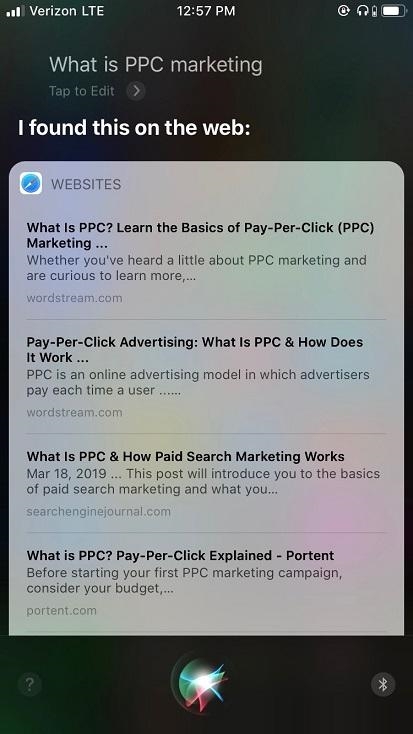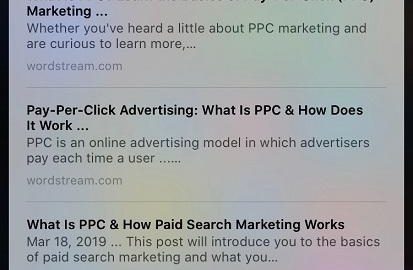It’s no secret that our friends over at Google like to tweak their search algorithm. And although this model of constant improvement is certainly cause for celebration among everyday users, it can give SEOs and copywriters a fair bit of anxiety. After all, if the rules of the game are constantly changing, how are you supposed to put together a winning strategy?

Ranking well on Google is pretty powerful. Via SparkToro.
Here’s the good news: The fundamental rules of SEO copywriting are here to stay. Don’t get me wrong—learning to adapt is definitely a valuable skill. But as important as flexibility is, you can rest (somewhat) easy knowing that some things in the SEO copywriting world never change.
Let’s get into it. Throughout this post, I’ll share a few examples of good work being done by folks around the marketing community. Without further ado, here are nine essential SEO copywriting rules to help you flourish in the year 2020:
- Understand (and match) keyword intent
- Get to the point
- Refrain from keyword stuffing
- Speak your audience’s language
- Shoot for the featured snippet
- Think hard about your headline
- Optimize your meta tags
- Target ancillary keywords
- Don’t forget about voice search
1. Understand (and match) keyword intent
For the most part, this list of SEO copywriting rules is assembled in no particular order—I don’t necessarily think rule #4 is more important than rule #8. That being said, I’m kicking things off with keyword intent for a specific reason: It’s fundamental to your SEO success.
Real quick for anyone who’s unfamiliar or in need of a refresher: “Keyword intent” refers to the reason people search for the keyword you’re thinking about targeting. Generally speaking, there are three broad types of keyword intent:
- Informational: user wants to learn more about something, like a topic, product, or industry. Example: “history of valentine’s day”
- Navigational: users wants to visit a specific website or web page. Example: “1800 flowers”
- Commercial: user wants to buy a product or service. Example: “buy bouquet of flowers”
Since it’s in Google’s best interest to deliver its users top-notch search results, it rewards marketers who closely match keyword intent. If you tried to target the keyword “history of valentine’s day” with the pricing page for your flower delivery service, you wouldn’t perform very well in the organic search results. Why? Because you’d fail to match keyword intent.

Whether you’re writing copy for your homepage, a blog post, or a product description, effective SEO copywriting starts with an appreciation for the importance of keyword intent. Think carefully about what users are looking for, and then do your best to give it to them.
2. Get to the point
I’ll admit it: I’ve been known to write a lengthy introduction every now and then. As valuable as that may be for those writing term papers or Dickensian novels, when we’re talking about SEO copywriting, we have to keep in mind the ultimate goal: to create relevant content. Relevant content, after all, is the stuff Google puts at the top of the organic results.
Though creating relevant content is largely about matching keyword intent, that’s not the only consideration; it’s also important to prove to Google that your content is pertinent. As I’ve learned first-hand, an effective way to prove the pertinence of your content is to target your main keyword early on in your copy.
To see what I mean, take a look at the first two paragraphs of this HubSpot article about writing email subject lines:

50 words in and the writer’s already targeted her main keyword three times. Is that the sole reason this post tops the organic results? No, but it’s certainly one of them. Take a page out of the HubSpot playbook and increase keyword density at the beginning of your next blog post.
3. Refrain from keyword stuffing
To be clear, there’s an important difference between increasing keyword density at the beginning of your next blog post and engaging in what’s known as keyword stuffing—the practice of excessively targeting your main keyword in an attempt to improve organic search performance. Whereas the former is a fair-and-square way to demonstrate the relevance of your content, the latter is an outdated form of cheating.
I recommend staying away from keyword stuffing for a couple different reasons, one of them being the fact that it’s a tremendous waste of your time. I mean, c’mon, it’s 2020, people. If you genuinely believe that Google still falls for stuff like this—
“Email subject lines are important because email subject lines determine whether or not people open your emails. It’s imperative that you A/B test your email subject lines because otherwise you’ll have no idea which email subject lines work best and you’ll be left with middle-of-the-road email subject lines that nobody cares about.”
—y’all are in for a rude awakening. (That excerpt isn’t from the HubSpot article, by the way. I made it up to prove a point.)
The other reason I suggest you refrain from keyword stuffing is that it makes for horrendous user experience. Nobody wants to read something that’s clearly written to appease an algorithm. If you engage in keyword stuffing, no one will stay on your website for very long.
4. Speak your audience’s language
Keyword research tools are great. Whether you’re a content marketer or a PPC specialist, tools like WordStream’s (it’s free) are often lifesavers.
That being said, there’s another amazing tool—if you can even call it that—that too few online marketers use to their advantage. It’s free, easily accessible, and immensely helpful for anyone in the business of SEO copywriting.
I’m talking about the related searches section at the bottom of the Google SERP.

Let’s say you’re a marketer at an email marketing software company and you’ve been tasked with writing a blog post around the keyword “does email marketing work.” Search that query on Google, scroll to the bottom of the results page, and bask in the glory of highly valuable information: a list of frequently searched queries that are relevant to your main keyword. “How effective is email marketing,” “is email still relevant,” “email marketing stats”—the list goes on.
At absolutely no cost to you, the related searches section gives you the power to speak your audience’s language—to mimic the words and phrases they use when searching for the answers you’re trying to provide. Incorporate some of those suggestions into your content and your SEO copywriting will get a huge boost.
5. Shoot for the featured snippet
As Rand Fishkin discussed at length on the SparkToro blog back in August 2019, less than half of Google searches result in a click—paid or organic. Most of the time, users leave the SERP without clicking a single hyperlink.
There’s a multitude of explanations behind this trend, of course, but for the purposes of this blog post I’m really only interested in one: the featured snippet. Even if you don’t think you’re familiar with the featured snippet, you most certainly are—it’s the little box that sometimes appears at the top of the SERP and gives you a small dose of highly relevant information.

If you search for the etymology of “robot,” there’s no real reason to click on any link—everything you need to know (assuming you’re looking for a quick, basic answer) is included in the featured snippet. Would some people click through to the full Wikipedia article or scroll down the page in search of a different source? Sure. But the proof is in the pudding: A lot of people are cool with simply reading the featured snippet and going on with the rest of their day.
So—what does that mean for you and your SEO copywriting strategy? When appropriate, you have to shoot for the featured snippet. If you’re addressing a question that can be answered with a handful of sentences—e.g., what is the average Google Ads CTR—make sure that handful of sentences is included somewhere in your content. By doing so, you give yourself a better chance of winning the featured snippet and delighting your target audience. Even if some people don’t click through, at least you’re boosting your brand image.
6. Think hard about your headline
If I’m guilty of one SEO copywriting sin—I’m guilty of several, but whatever—it’s my lack of concentration when it comes to writing headlines. I have a bad tendency to spend hours on a 2,000-word blog post and subsequently dedicate 45 seconds to writing a mediocre headline. That’s like spending years on the interior design of a beautiful home and then building a single doorway that’s only big enough for dogs and cats.
If your headline stinks, nobody is going to click through to your website. Don’t be like me. Set aside a substantial amount of time for brainstorming headlines. It may feel like a waste of time at first, but trust me—when your organic CTR skyrockets and your pageviews go through the roof, you’ll be happy you did it.
WordStream’s Director of SEO & Content Elisa Gabbert has given me no shortage of headline-writing pointers in the time that we’ve worked together. Here’s one of my favorites: When possible, establish your authority over the subject matter you’re discussing. As an example, take a look at the headline for this blog post written by Asi Dayan:

If that’s not a click-worthy headline, I don’t know what is. By referencing the specific (and very large) amount of money he’s spent on Google Ads, Asi cleverly establishes his authority in the PPC realm. With a high CTR comes a better organic ranking, and with a better organic ranking comes a greater volume of clicks. Headline copywriting is a powerful thing.
7. Optimize your meta tags
As much as I encourage all you copywriters out there to get creative with your headlines, there’s a practical element you should always have on the mind: the fact that Google will likely truncate your headline (a.k.a. title tag) if it’s longer than 60 characters. Speaking from experience, few things are more frustrating than writing a heater of a headline only to see it get truncated on the SERP. It’s not enough to be creative; you also have to be concise.

The idea is there. The concision? Not so much.
Your headline is crucial, but it’s not the only meta tag in need of optimization: You also need to be thoughtful about your description (the text that displays directly below your URL). I’m not going to lie to you and tell you that everyone takes description copy into consideration before deciding which organic result to click; that would be silly.
That being said, there are indeed folks who will read your description and use it to judge whether or not they care about what you have to say. Plus, Google looks there to find indicators of relevance (i.e., keywords). Therefore, it’s important that you take time to write thoughtful descriptions—descriptions that both entice people to click and convince Google that your content is worth ranking. Behold:

Ignore the title for now. That right there is an effective, concise description
8. Target ancillary keywords
Say it with me, friends: A single piece of content can rank for several keywords. Ideally, much of your content will rank for several keywords. I know that many of you already know this, but it’s a concept I didn’t fully appreciate until I’d heard it a number of times. Just in case someone like me stumbles across this blog post (fairly likely, if you ask me), I repeat: A single piece of content can rank for several keywords.
Once again, I’m going to use WordStream as an example. If you Google search the query “seo basics,” you’ll find the beginner’s guide to SEO.

Scroll down to the bottom of the SERP and you’ll meet again with our old friend: the related searches section. There, you’ll see “seo fundamentals” as a suggested query. Give that a quick search, scroll roughly halfway down the SERP, and behold:

At the bottom of that SERP, of course, is the ever-reliable related searches section. Among some other queries, you’ll see the suggestion “seo for beginners.” You know what’s coming next, right? Toss that Bad Larry in the Google search box, hit the little magnifying glass (or, like a normal person, the enter key), and feign surprise at what you find at the bottom of the SERP:

Before you submit an angry comment, allow me to acknowledge that different people see different SERPs for the same search queries. That’s a valid observation, but my larger point still stands: Targeting several related keywords with a single piece of content allows you to reach a larger (yet still relevant) audience.
With the help of Google’s suggested queries and WordStream’s Free Keyword Tool, you can find all the ancillary keywords you need to thrive in 2020.
9. Don’t forget about voice search
Is the ongoing hype surrounding voice search a tad overblown? Perhaps. I, for one, don’t subscribe to the idea that optimizing for voice search should be your single biggest SEO priority in the year 2020. Things like matching keyword intent and winning the featured snippet are still far more pressing, in my opinion.
Alllllll that being said, you shouldn’t completely ignore voice search, either. Estimates vary depending on who you ask, of course, but it’s worth noting that roughly two-thirds of people between the ages of 25 and 49 speak to their voice-enabled devices at least once per day. That voice search is becoming increasingly common is reason enough, I think, to incorporate some basic tactics into your SEO copywriting strategy.
Example: Try optimizing some of your content for question-based keywords. According to Google, 41% of people who use voice-activated speakers say they talk to their devices as if they’re human. Naturally, that means a lot of their queries are framed as questions rather than keywords. A question, after all, is far more conversational than a string of keywords.

One last time, I’ll use WordStream as an example. When I activated Siri and asked “What is PPC marketing?”—more conversational, I’d argue, than simply saying “PPC marketing”—the top result was this article about the basics of PPC. As you can see in my screenshot, the question “What is PPC?” is at the beginning of the article’s title. Because this piece of content targets a question-based query, it’s well-optimized for the era of voice search. Give this tactic a shot as you create new content and write new copy!
Digital & Social Articles on Business 2 Community
(90)







